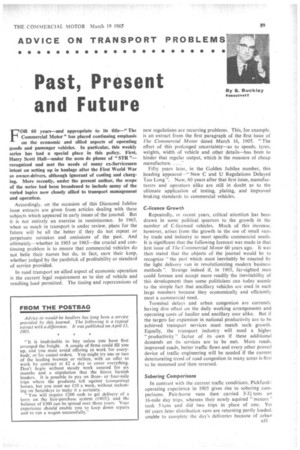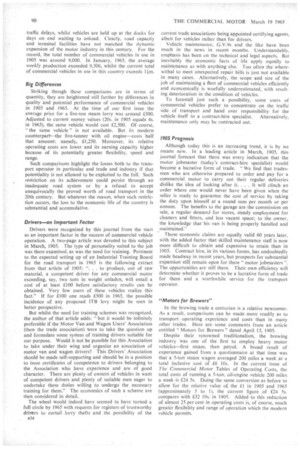Past, Present and Future
Page 91

Page 92

If you've noticed an error in this article please click here to report it so we can fix it.
FOR 60 years—and appropriate to its title—" The Commercial Motor" has placed continuing emphasis on the economic and allied aspects of operating goods and passenger vehicles. In particular, this weekly series has had a special place in this policy. First, Harry Scott Hall—under the nom de plume of " STR "recognized and met the needs of many ex-Servicemen intent on setting up in haulage after the First World War as owner-drivers, although ignorant of costing and charging. More recently, under the present author, the scope of the series had been broadened to include many of the varied topics now closely allied to transport management and operation.
Accordingly, on the occasion of this Diamond Jubilee issue extracts are given from articles dealing with these subjects which appeared in early issues of the journal. But it is not entirely an exercise in reminiscence. In 1965, when so much in transport is under review, plans for the future will be all the better if they do not repeat or perpetuate mistakes and omissions of the past. And ultimately—whether in 1905 or 1965—the crucial and continuing problem is to ensure that commercial vehicles do not belie their names but do, in fact, earn their keep, whether judged by the yardstick of profitability or standard of service provided.
In road transport an allied aspect of economic operation is the current legal requirement as to size of vehicle and resulting load permitted. The timing and repercussions of
new regulations are recurring problems. This, for example, is an extract from the first paragraph of the first issue of The Commercial Motor dated March 16, 1905. "The effect of this prolonged uncertainty—as to speeds, tyres. weights, width of vehicle and other details—has been to hinder that regular output, which is the measure of cheap manufacture......
Fifty years later, in the Golden Jubilee number, this heading appeared—" New C and U Regulations Delayed Too Long ". Now, 60 years after that first issue, manufacturers and operators alike are still in doubt as to the ultimate application of testing, plating, and improved braking standards to commercial vehicles.
C-licence Growth
Repeatedly, in recent years, critical attention has been drawn in some political quarters to the growth in the number of C-licensed vehicles. Much of this increase, however, arises from the growth in the use of small vans by trade and industry to meet specific commercial needs. It is significant that the following forecast was made in that first issue of The Commercial Motor 60 years ago. It was then stated that the objects of the journal would be to recognize "the part which must inevitably be enacted by the light delivery van in revolutionizing modern business methods ". Strange indeed if, in 1905, far-sighted men could foresee and accept more readily the inevitability of this development than some politicians can today accede to the simple fact that ancillary vehicles are used in such large numbers because they economically and efficiently meet a commercial need.
Terminal delays and urban congestion are currently having dire effect on the daily working arrangements and operating costs of haulier and ancillary user alike. But if the targets for expansion in national productivity are to be achieved transport services must match such growth. Equally, the transport industry will need a higher "productivity" factor of its own if these additional demands on its services are to be met. More roads, improved roads, better traffic flows and every other proved device of traffic engineering will be needed if the current deteriorating trend of road congestion in many areas is first to be stemmed and then reversed.
Sobering Comparisons In contrast with the current traffic conditions, Pickfordsoperating experience in 1905 gives rise to sobering comparisons. Pair-horse vans then carried 3-3i tons on 16-mile day trips, whereas their newly aquired "motors " took 5 tons and did two trips in place of one. Yet 60 years later distribution vans are returning partly loaded. unable to complete the day's deliveries because of urban
traffic delays, whilst vehicles are held up at the docks for days on end waiting to unload. Clearly, road capacity and terminal facilities have not matched the dynamic expansion of the motor industry in this century. For the record, the total number of commercial vehicles in use in 1905 was around 9,000. In January, 1965, the average weekly production exceeded 9,506, whilst the current total of commercial vehicles in use in this country exceeds Big Differences Striking though these comparisons are in terms of quantity, they are heightened still further by differences in quality and potential performance of commercial vehicles in 1905 and 1965. At the time of our first issue the average price for a five-ton steam lorry was around £500. Adjusted to current money values (20s. in 1905 equals 4s. in 1965), the same vehicle would cost £2,500. Of course, "the same vehicle" is not available. But its modern counterpart—the five-tonner with oil engine—costs half that amount: namely, £1,250. Moreover, its relative operating costs are lower and its earning capacity higher because of its potentially greater flexibility, speed and range.
Such comparisons highlight the losses both to the transport operator in particular and trade and industry if that potentiality is not allowed to be exploited to the full. Such restriction on its achievement could persist through an inadequate road system or by a refusal to accept unequivocally the proved worth of road transport in the 20th century. But whatever the reason, when such restriction occurs, the loss to the economic life of the country is substantial and accumulative.
Drivers—an important Factor
Drivers were recognized by this journal from the start as an important factor in the success of commercial vehicle operation. A two-page article was devoted to this subject in March, 1905. The type of personality suited to the job was there examined, as was the need for training. Pertinent to the expected setting up of an Industrial Training Board for the road transport in 1965 is the following extract from that article of 1905: ". . . to produce, out of raw material, a competent driver for any commercial motor exceeding, say, two tons in weight unladen, will entail a cost of at least £100 before satisfactory results can be obtained. Very few users of these vehicles realize this fact." If for £100 one reads £500 in 1965, the possible incidence of any proposed ITB levy might be seen in better perspective.
But whilst the need for training schemes was recognized, the author of that article adds: "but it would be infinitely preferable if the Motor Van and Wagon Users' Association (then the trade association) were to take the question up and formulate some system of training drivers suitable for our purpose. Would it not be possible for this Association to take under their wing and organize an association of motor van and wagon drivers? This Drivers' Association should be made self-supporting and should be in a position to issue certificates of competence to drivers belonging to the Association who have experience and are of good character. There are plenty of owners of vehicles in want of competent drivers and plenty of suitable men eager to undertake these duties willing to undergo the necessary training for them." The economics of such a scheme are then considered in detail.
The wheel would indeed have seemed to have turned a full circle by 1965 with requests for registers of trustworthy drivers to curtail lorry thefts and the possibility of the s34 current trade associations being appointed certifying agents, albeit for vehicles rather than for drivers.
Vehicle maintenance, G.V.9s and the like have been much in the news in recent months. Understandably, emphasis has been on the technical and legal aspects. But inevitably the economic facts of life apply equally to maintenance as with anything else. Too often the wherewithal to meet unexpected repair bills is just not available in many cases. Alternatively, the scope and size of the job of maintaining a fleet of commercial vehicles efficiently and economically is woefully underestimated, with resulting deterioration in the condition of vehicles.
To forestall just such a possibility, some users of commercial vehicles prefer to concentrate on the traffic side of transport and hand over responsibility for the vehicle itself to a contract-hire specialist. Alternatively, maintenance only may be contracted out.
1905 Prognosis Although today this is an increasing trend, it is by no means new. In a leading article in March, 1905, this journal forecast that there was every indication that the motor jobmaster (today's contract-hire specialist) would become a lucrative form of trade. "We find that tradesmen who are otherwise prepared to order and pay for a commercial motor to carry out their regular deliveries dislike the idea of looking after it. . . . It will clinch an order where one would never have been given when the seller is ready to guarantee the cost of service by taking the duty upon himself at a round sum per month or per annum. The benefits to the garage are the commission on sale, a regular demani for stores, steady employment for cleaners and fitters, and less vacant space; to the owner, the knowledge that his van is being properly handled and maintained."
Those economic claims are equally valid 60 years later, with the added factor that skilled maintenance staff is now more difficult to obtain and expensive to retain than in 1905. Contract hire, in its various forms, has undoubtedly made headway in recent years, but prospects for substantial expansion still remain open for these motor jobmasters ". The opportunities are still there. Their own efficiency will determine whether it proves to be a lucrative form of trade for them and a worthwhile service for the transport operator.
"Motors for Brewers" In the brewing trade a centurian is a relative newcomer. As a result, comparisons can be made more readily as to transport operating experience and costs than in many other trades. Here are some comments from an article entitled " Motors for Brewers" dated April 13, 1905.
Despite their renowned traditionalism, the brewing industry was one of the first to employ heavy motor vehicles—first steam, then petrol. A broad result of experience gained from a questionnaire at that time was that a 5-ton steam wagon averaged 200 miles a week at a total inclusive cost of £6 10s. In the current issue of The Commercial Motor Tables of Operating Costs, the total costs of running a 5-ton, oil-engine vehicle 200 miles a week is £24 5s. Doing the same conversion as before to allow for the relative value a the £1 in 1905 and 1965 (approximately 5 to 1), the current figure of £24 5s. compares with £32 10s: in 1905. Aacled to this reduction of almost 25 per cent in operating costs is, of course, much greater flexibility and range of operation which the modern vehicle permits.












































































































































